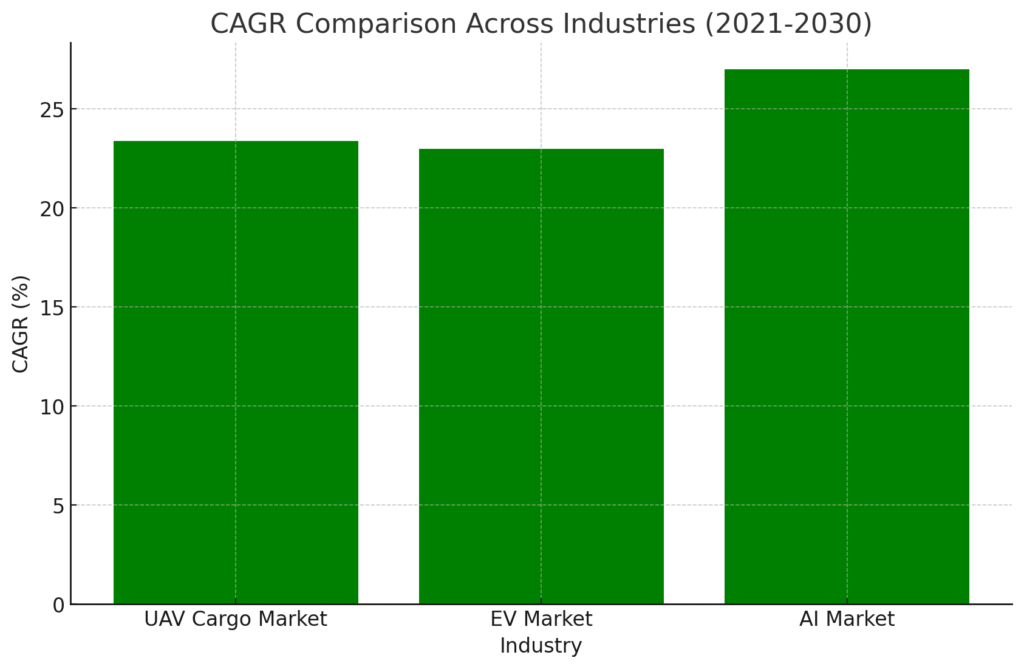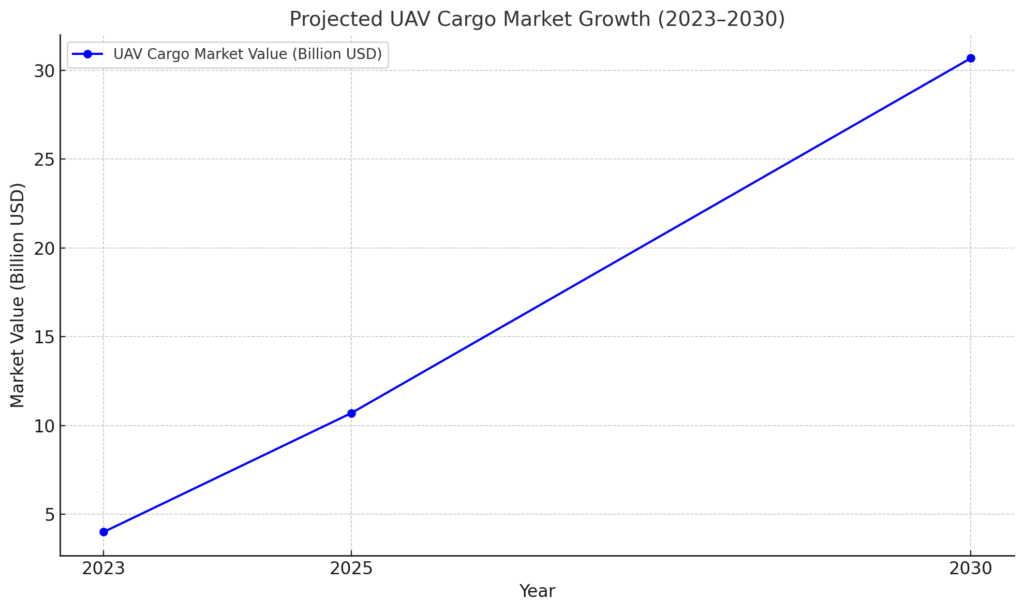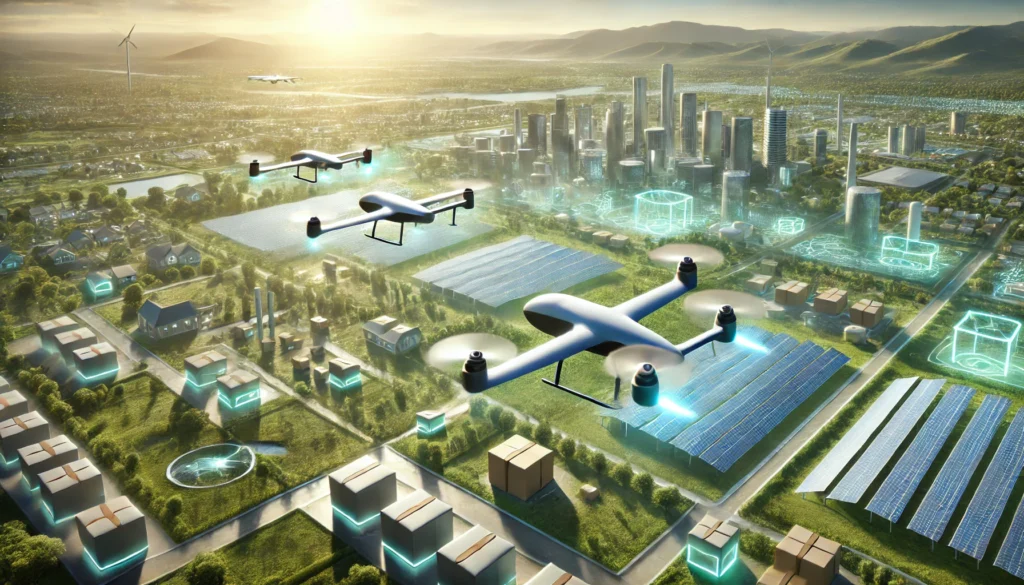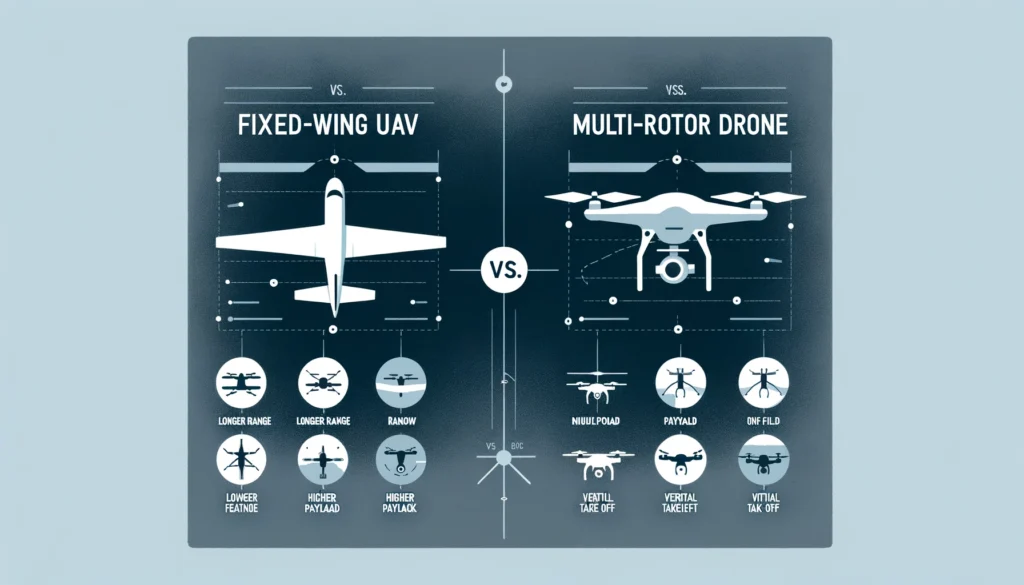The global economy is witnessing rapid transformations across various sectors, driven by innovation, sustainability, and the growing need for efficiency. One standout industry is the UAV cargo market, which is projected to grow from $4 billion in 2023 to $30.69 billion by 2030, at an impressive 23.4% Compound Annual Growth Rate (CAGR). This positions the UAV cargo market among the ranks of other high-growth industries like Electric Vehicles (EVs), Artificial Intelligence (AI), Renewable Energy, and more.

This article highlights the significant growth potential of UAV cargo while drawing comparisons to several industries experiencing similar or even higher growth rates.
UAV Cargo Market: A New Era in Logistics
The UAV cargo market is poised to disrupt traditional logistics by offering faster, more flexible, and cost-effective solutions. Key factors driving this growth include:
- Technological Advancements: Innovations in fixed-wing UAV design, AI, and autonomous navigation are enhancing efficiency and delivery speed.
- Demand for Speed and Efficiency: UAVs provide solutions for delivering goods in remote areas, during emergencies, and in congested urban environments.
- Sustainability: UAVs contribute to greener logistics by reducing reliance on traditional transport methods and cutting emissions.
These factors have placed UAV cargo in a high-growth bracket, comparable to some of the world’s leading industries.

High-Growth Industry Comparisons
1. Electric Vehicle (EV) Market
- CAGR: 23-25% (2021–2030)
- Growth Drivers: Growing environmental concerns, government incentives, and advancements in battery technology.
- Applications: Personal and commercial transportation, logistics, and ride-sharing platforms.
The EV market is booming as consumers, industries, and governments prioritize sustainable transportation. Just like UAVs are reshaping cargo delivery, electric vehicles are transforming the automotive industry with cleaner, more efficient mobility solutions.
2. Artificial Intelligence (AI) Market
- CAGR: 20-35% (2021–2030, depending on the segment)
- Growth Drivers: Increasing adoption across industries for automation, analytics, and customer experience improvements.
- Applications: Autonomous systems (including UAVs), machine learning, predictive analytics, and natural language processing.
AI plays a critical role in enhancing the capabilities of UAVs by enabling autonomous flight, optimizing delivery routes, and ensuring safe operation. With AI driving automation in various sectors, its growth trajectory aligns with the expansion of UAV cargo and logistics solutions.
3. Renewable Energy (Solar and Wind Energy)
- CAGR: 20-25% (2021–2030)
- Growth Drivers: Demand for clean energy, declining costs of solar and wind technology, and supportive government policies.
- Applications: Power generation, residential/commercial installations, and energy storage systems.
As the renewable energy sector grows, the sustainability benefits align with the environmental advantages of UAV technology. Both industries contribute to reducing carbon emissions and improving operational efficiency.
4. E-Commerce and Online Retail
- CAGR: 14-25% (2021–2028)
- Growth Drivers: Increasing internet penetration, mobile device usage, and the rise of digital payments.
- Applications: Retail, logistics, last-mile delivery, and digital marketplaces.
The e-commerce industry has been one of the biggest drivers for UAV cargo, especially in last-mile delivery solutions. UAVs are enabling faster, more efficient deliveries, particularly in remote or hard-to-reach areas.
5. Fintech (Financial Technology)
- CAGR: 20-25% (2021–2030)
- Growth Drivers: Demand for digital banking, mobile payments, and blockchain-based solutions.
- Applications: Digital banking, payments, peer-to-peer lending, insurtech, and investment platforms.
Just as fintech is revolutionizing finance by offering more convenient and secure services, UAV cargo is transforming logistics by providing more efficient delivery options. The shift toward digitization in both industries is driven by similar consumer demand for speed, accessibility, and efficiency.
6. Cloud Computing
- CAGR: 15-20% (2022–2030)
- Growth Drivers: Rising demand for cloud services, data storage, and the increasing popularity of SaaS, IaaS, and PaaS business models.
- Applications: Scalable IT solutions, remote work, and AI integration.
Cloud computing is critical to the growth of industries like AI and UAV logistics, providing the infrastructure needed for real-time data analytics, route optimization, and system automation. As more businesses migrate to cloud-based services, this sector continues to grow rapidly.
7. Biotechnology and Personalized Medicine
- CAGR: 22-25% (2021–2030)
- Growth Drivers: Advances in genomics, targeted therapies, and biopharmaceuticals, along with rising investments in research and development.
- Applications: Gene editing, cancer therapies, diagnostics, and regenerative medicine.
Much like UAV cargo, biotechnology is at the cutting edge of innovation, offering personalized solutions that improve efficiency and outcomes. Both sectors are experiencing strong growth driven by technological advancements and evolving consumer needs.
Common Growth Drivers Across Industries
Despite their differences, these high-growth industries share several common factors that drive their success:
- Technological Innovation: From UAVs and AI to EVs and fintech, technological advancements are key to increasing efficiency, reducing costs, and creating new applications.
- Sustainability: Industries like renewable energy, EVs, and UAVs are prioritizing eco-friendly solutions to meet global sustainability goals.
- Shift in Consumer Behavior: As consumers demand faster, more efficient, and more sustainable products and services, industries are rapidly evolving to meet these expectations.
- Government Policies and Incentives: Supportive regulations, subsidies, and incentives play a critical role in accelerating growth across sectors like renewable energy, EVs, and UAVs.
Conclusion
The UAV cargo market is rapidly evolving and shares a growth trajectory with some of the world’s most transformative industries, including electric vehicles, artificial intelligence, fintech, and biotechnology. Each of these sectors is being propelled by technological advancements, sustainability efforts, and changing consumer preferences. With its 23.4% CAGR, the UAV cargo industry is set to reshape logistics by offering faster, more efficient, and environmentally friendly delivery solutions. As regulations and infrastructure develop, UAV technology will continue to play a crucial role in the future of logistics, much like the revolutionary impact of electric vehicles, AI, and renewable energy in their respective fields.
The data and insights used in this article are sourced from various reputable industry reports and publications, including:
- Unmanned Systems Technology – for insights on the UAV cargo market growth, key segments, and applications.
- Electric Vehicle Market Reports (from agencies such as McKinsey & Company and International Energy Agency [IEA]) – for information on the projected CAGR of the EV market and its key drivers.
- Artificial Intelligence Market Reports (sources like Gartner, IDC, and Deloitte) – for data on the AI market’s growth rate, applications, and drivers.
- Renewable Energy Reports (from International Renewable Energy Agency [IRENA], Bloomberg NEF, and IEA) – for solar and wind energy growth projections.
- E-Commerce and Retail Reports (from Statista, Grand View Research, and eMarketer) – for CAGR and growth drivers of global online retail and e-commerce.
- Fintech Industry Reports (from PwC, Accenture, and World Economic Forum) – for the growth of financial technology markets and major trends.
- Cloud Computing Market Reports (sources like IDC and Gartner) – for insights on the expansion of cloud computing services.
- Biotechnology and Personalized Medicine Reports (from GlobalData, Allied Market Research, and Frost & Sullivan) – for growth projections and advancements in the biotechnology sector.


